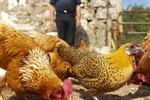
Although many people have a stereotypical image of a rooster with large red wattles, the truth is that laying hens also have ample wattles. As a matter of fact, a hen's wattles are often used to predict her value as an egg producer. Healthy wattles are considered to be a sign of good egg production and are a positive trait in laying hens.
What is a Wattle?

Wattles are two elongated, fleshy, thin lobes of skin that hang down from the lower side of a chicken's head. Both male and female chickens have wattles, which help them to stay cool during warmer weather. Blood circulates from the body into the comb and wattles, where heat can more easily transfer to the surrounding air.
Breed Variation

Most wattles on laying hens are bright red, such as in the Rhode Island Red breed. However, other breeds vary slightly in the color of their wattles, usually from a deep, dark red to a lighter, rosy pink color. It is important to observe the color of a chicken's wattles when it is good health, since changes in wattle color can indicate a health problem.
Changed Appearance

If a laying hen is healthy, her wattles will be bright in color, large, soft and waxy. If the wattles change in color or shrink in size, this may indicate a health problem or lack of robust productivity. Wattles may also develop a dried, shriveled, hard appearance, which is often associated with dehydration or other serious health issues. Changes in wattle appearance is often a major factor commercial egg producers consider when determining which hens to cull.
Signs of Trouble
The wattles in free ranging chickens may develop blackened areas. This is not an indicator of a serious health issue, rather it indicates frostbite, which is not life threatening in most cases. Occasionally chickens may fight and torn or injured wattles are a common occurrence. Swollen wattles can be the result of circulatory problems or infection.
Intervention

If a laying hen develops signs of frostbite or a minor injury to her wattles, home care is fairly easy. If the wattles swell or shrink, this often is the manifestation of a more systemic problem and you should consider veterinary intervention to diagnose and determine the proper treatment for the problem.
References
Resources
Photo Credits
-
Jupiterimages/Photos.com/Getty Images



